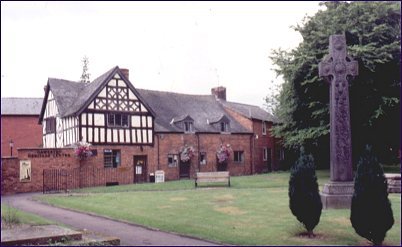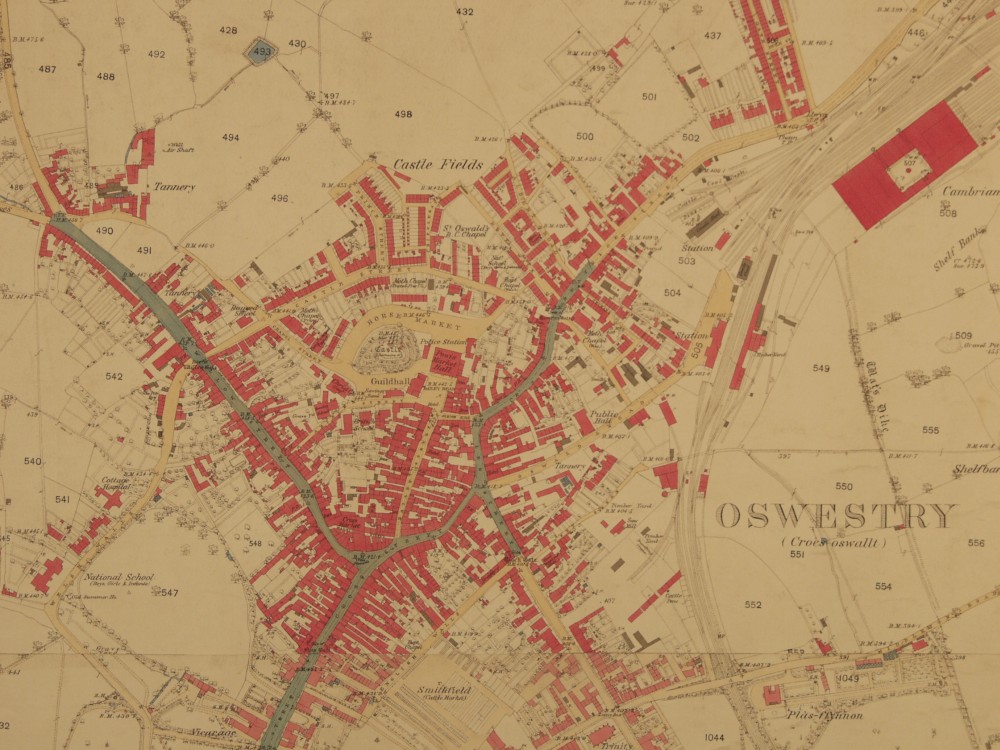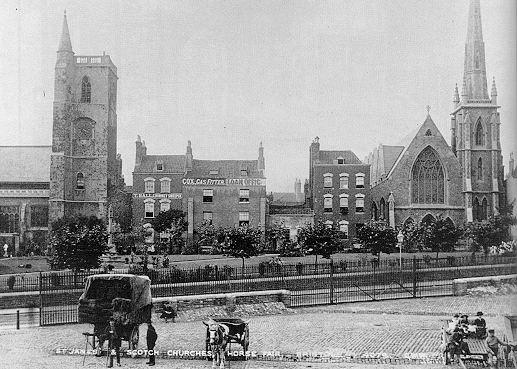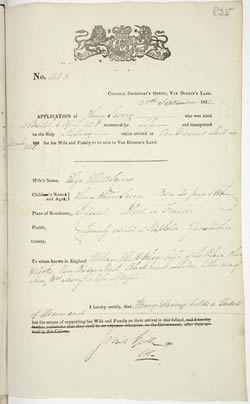 |
|

Butcombe archway, North Somerset. Butcombe was
the birthplace of Henry Savery, 4 August 1791
 Oswestry Grammar School, Shropshire where Henry Savery went to school. |
 Map of Oswestry, Shropshire |
Savery’s early career was marked by misfortune and incompetence. Born on August 4, 1791, at Butcombe Court, Somerset (see above), he was the sixth son to prominent banker John Savery. Edmund Morris Miller plausibly speculates that he was educated at Owestry Grammar School (see above), Shropshire, and that his early manhood was spent in London. Here he met Eliza Elliott Oliver, daughter of Blackfriars businessman William Elliot Oliver. They married in about 1815 and moved to Stapleton, near Bristol, where son Henry Oliver was born the following year.

St James Church, Bristol where Henry Savery married Eliza Elliott Oliver October 1815
In 1817 Savery and a partner named Bigg took over a sugar-refinery (or sugar-bakery, as it was then called), and the first of his troubles began: the company soon began to founder and just two years later Savery was bankrupt. Seemingly undeterred, he assumed editorship of the Bristol Observer took over the business of a “West India and General Broker,” but quickly abandoned both ventures, and returned to sugar-refining in partnership with a man named Saward.
As Cecil Hadgraft observes [interlink with Hadgraft article], these haphazard excursions suggests that Savery “had grandiose ideas, and over-extended the capacity of each firm that was unlucky enough to have him as its guiding spirit.” Indeed, Savery was soon in serious financial trouble. The full story is complicated and confused, but certainly Savery entered into agreements he had no hope of honouring and, over a period of about two years, used fictitious names to forge bills worth between thirty and forty thousand pounds. Near the end of 1824 the matter came to a head in a dramatic series of events: Savery, alarmed by the recent execution of famous forger Henry Fauntleroy, decides to abandon his family and flee to America on board the Hudson, due to depart Cowes on December 9. His distressed wife attempts to follow him, but is ordered to return to Bristol. He has already reached London when Saward by chance notices an irregularity in one of the forged bills, looks into the affairs of the company, and sets out to London in pursuit. Just thirty minutes before the hour of sailing, Saward and a police officer row out to the Hudson: with characteristic melodrama, Savery throws himself into the sea and repeatedly smashes his head against the side of the vessel. He is pulled to safety and taken back to Bristol. From this time until his committal, he displays symptoms of what is now known as manic depression: deep lows followed by manic hysteria.
The drama continued at the trial, which took place on April 4, 1825, before Lord Gifford at the Bristol Assize. In a misguided bid for mercy, Savery surprises the court by pleading guilty to fraud – an action that necessitates his own death sentence. He is taken from the court and urged to reconsider, but when he again asserts his guilt, the bewildered Gifford is forced to condemn him to death by hanging. According to one newspaper account, “the prisoner, on hearing [the sentence], seemed to lose all power of breathing …” and one of the prosecutors, George Smith, presses forward to the bench to urge Gifford to reconsider. Gifford, himself affected by the scene, appoints April 22 as the date of execution.
But Savery has many powerful friends prepared to lobby the Home Department on his behalf, and on April 21 – less than twenty-four hours before the appointed time of his hanging – his sentence is commuted to transportation for life. He left Woolwich on board the Medway [interlink with info about the ship?] on July 20, and arrived in Hobart in early December. The Colonial Times mentions Savery in its report of the ship’s arrival, noting that he was “treated with the greatest kindness and attention” during the five-month voyage.
This special treatment seemed set to continue. He was assigned to work at the Colonial Secretary’s Office, but later transferred to the Colonial Treasury. His employment, however, was the cause of hostility among two groups of colonists: those who were outraged that a convict should be allowed to manage confidential governmental matters, and those who wanted Savery’s accountancy skills for themselves. Numerous letters were sent to Downing Street demanding his dismissal; ( See Letter to Lieut. Governor Arthur from London, objecting to Savery's special treatment- AOT GO 1-3 p. 304-308) Arthur eventually responded by reducing his wages and establishing a committee to investigate fresh allegations against him of dishonest dealings. These allegations were eventually dropped. However, as Hadgraft notes, “when almost any inquiry was made into almost any activity Savery was engaged in, then explanations tended to be long, involved, and sometimes devious.” In 1827, for instance, he was employed by Captain B.B. Thomas at the Van Diemen’s Land Establishment, a large agricultural firm; by 1828, both men were under suspicion of inefficiency and malpractice.
Early in 1828 Eliza Savery set out with her twelve-year-old son on the Jessie Lawson to join her husband in Tasmania. Bad weather caused the ship to be wrecked on the English coast, but no lives were lost. She tried again a few months later on board the Henry Wellesley, accompanied by family friend Algernon Montagu [Algernon Montagu ADB], who was on his way to become Tasmania’s Attorney General. It seems likely that Eliza was subject to his romantic interest over the course of the voyage. [See Reminiscences of the life of Sarah Benson Walker, 1812-1893 page 38]. She arrived in the colony in late October of 1828, and was quickly disillusioned as to her husband’s position in the colony: he was still a convict without a ticket-of-leave, and was under threat of imprisonment for debt. A week after her arrival, Savery attempted suicide by cutting his throat, but was saved by Dr. William Crowther. He was imprisoned on December 19. In the following February, only three months after her arrival, Eliza and her son returned to England on board the Sarah. In 1832, after he received his ticket-of-leave, Savery applied to have her brought out to Tasmania on a free passage. She did not respond.
Perhaps it is no coincidence that at this point Savery turned to writing. Over a period of fifteen months spent in prison he wrote The Hermit of Van Diemen’s Land – a series of thirty sketches of Hobart life which were published in Andrew Bent’s Colonial Times under the name of Simon Stukeley. A libel case was brought against Bent by Gamaliel Butler, but Savery’s identity remained a secret and for once he managed to stay out of trouble. Released from jail early 1830, Savery was assigned to work for Major Macintosh in New Norfolk. It was during this time that he completed Quintus Servinton.
Legal troubles, however, continued to plague him: Link to Application for Ticket of Leave - See Petition for Ticket of Leave . He was granted his ticket-of-leave in the June of 1832
He was deprived of it twelve months later for breaking the law forbidding any convict to be published in the newspapers. His ticket-of-leave was eventually reinstated, but over the next five years, he was involved with several legal actions brought either by or against him, all involving money. In 1838 he received his conditional pardon and took over a farm at Hestercombe, but was again overcome with debt; again, he resorted to writing fictitious bills. He was arrested on September 29, 1840, and a month later brought before the same Algernon Montagu assigned to “protecting” his wife on her journey to Tasmania. [See Colonial Times accounts October 1840] He pleaded not guilty to the charge of attempting to defraud Richard Cooke, and was sentenced to transportation for life to Port Arthur. “I will not,” declared Montagu at the sentencing, “so far stultify myself as to suppose [that] reformation will be shown by you.” And sadly, as we know from Burn’s account, he was right.
(Biographical notes by Elizabeth Mead)
See also:
Henry Savery entry in The Companion to Tasmanian History
Henry Savery entry in Wikipedia
Henry Savery entry in Australian Dictionary of Biography Online
home | Henry Savery | businessman | forger | convict | author | England | Port Arthur | transported | Van Diemen's Land | Quintus Servinton
| © University of Tasmania ABN 30 764 374 782 CRICOS Provider Code 00586B | Copyright & Disclaimers | Accessibility | Site Feedback International Students | Future Students | Research | The Graduate School |
